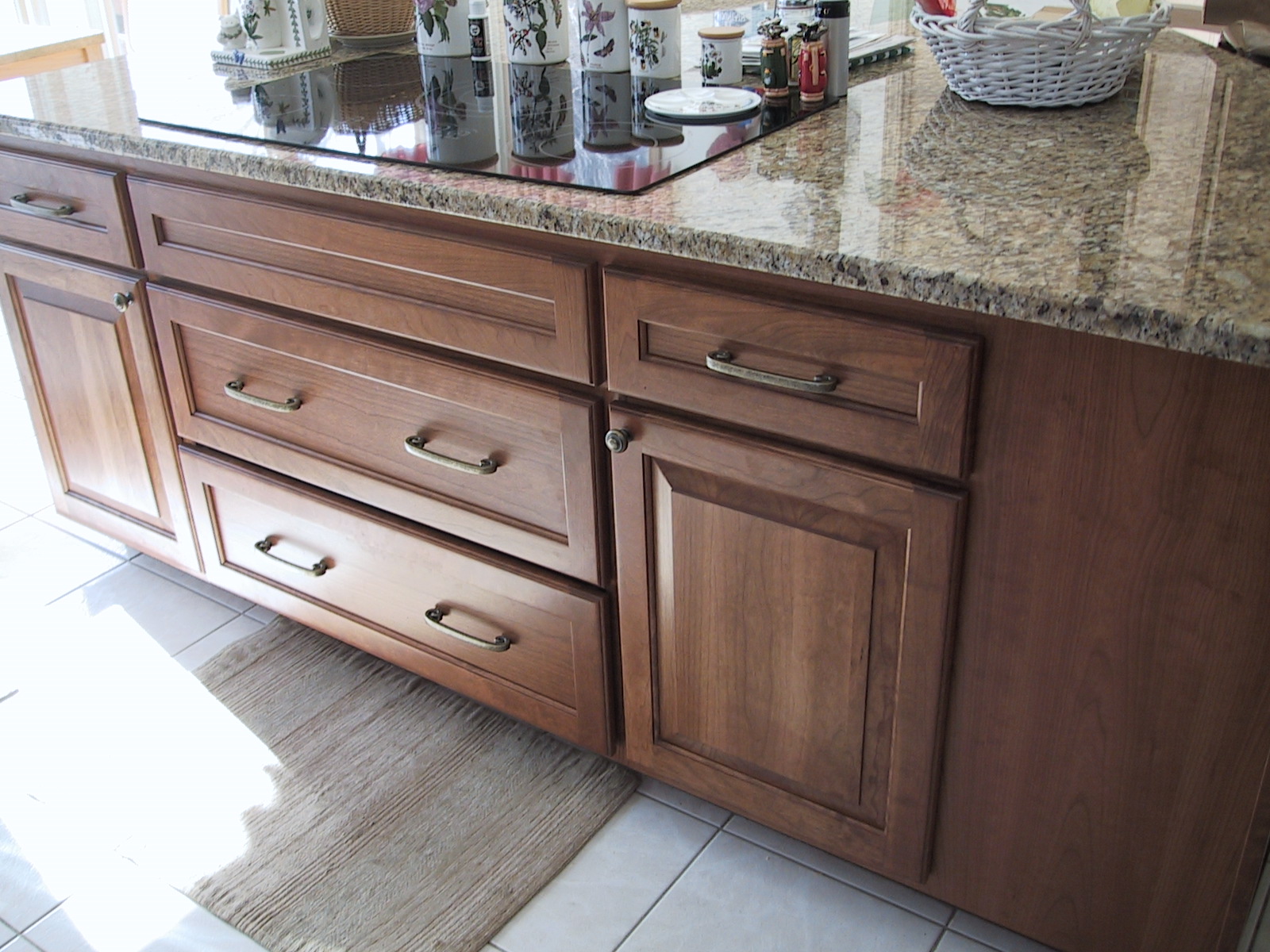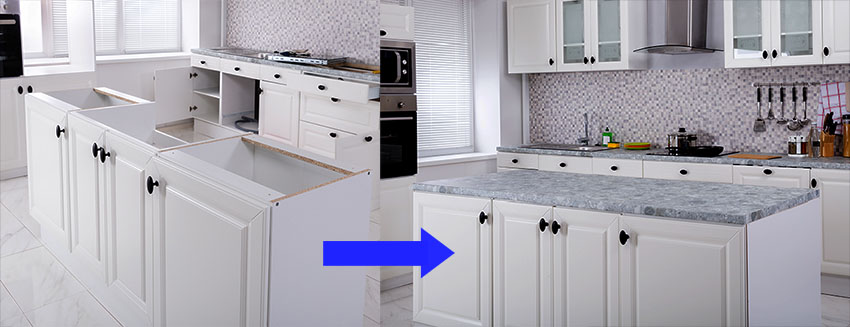Reasons to Replace Countertops Without Replacing Cabinets: Can You Replace Countertops Without Replacing Cabinets

Replacing countertops without replacing cabinets offers a cost-effective and visually impactful way to refresh your kitchen. This approach allows you to achieve a modern and functional kitchen without undertaking a full-scale renovation, saving time, money, and disruption.
Aesthetic Enhancement
Replacing countertops can significantly impact your kitchen’s aesthetic appeal. By choosing a new material, color, or pattern, you can instantly transform the look and feel of the space. For example, swapping out outdated laminate countertops for sleek quartz or granite can create a more luxurious and modern atmosphere. You can also choose a countertop material that complements your existing cabinets, backsplash, or flooring, creating a cohesive and visually pleasing design.
Improved Functionality, Can you replace countertops without replacing cabinets
A countertop replacement can also enhance the functionality of your kitchen. For example, choosing a durable and heat-resistant material like quartz or granite can provide a more practical and long-lasting surface for food preparation and cooking. Installing a countertop with a built-in sink or a large overhang for seating can also improve the overall efficiency and convenience of your kitchen.
Cost Savings
Replacing countertops alone is significantly less expensive than a full kitchen renovation. A full kitchen renovation can cost tens of thousands of dollars, while countertop replacement typically ranges from a few hundred to a few thousand dollars, depending on the material and size of your kitchen.
Countertop Materials and Considerations

Choosing the right countertop material is a crucial decision in any kitchen renovation. It impacts not only the aesthetics but also the functionality and longevity of your kitchen. This section will delve into the characteristics of popular countertop materials, helping you make an informed decision for your project.
Countertop Material Comparison
Understanding the pros and cons of each countertop material is essential for making the right choice. Here’s a breakdown of popular options:
Granite
Granite is a natural stone known for its durability, heat resistance, and unique patterns. It’s a popular choice for kitchens due to its elegant appearance and ability to withstand heavy use.
- Pros: Durable, heat-resistant, scratch-resistant, unique patterns, adds value to the home.
- Cons: Expensive, requires sealing, prone to staining if not sealed properly, can be porous, may chip or crack under impact.
Quartz
Quartz is an engineered stone made from crushed quartz crystals and resin. It offers a variety of colors and patterns, making it a versatile choice for kitchens.
- Pros: Durable, scratch-resistant, non-porous, easy to maintain, wide range of colors and patterns, resists staining.
- Cons: More expensive than laminate, can be susceptible to heat damage, less natural than granite.
Laminate
Laminate countertops are made from layers of paper impregnated with resin and covered with a decorative plastic laminate. They are a budget-friendly option that comes in various colors and patterns.
- Pros: Affordable, easy to install, wide range of colors and patterns, water-resistant.
- Cons: Susceptible to scratches and heat damage, not as durable as natural stone or engineered stone, seams can be visible, not as aesthetically appealing as natural stone.
Butcher Block
Butcher block countertops are made from hardwood, often maple or walnut. They are known for their durability and warmth.
- Pros: Durable, natural, warm to the touch, can be refinished, environmentally friendly.
- Cons: Expensive, requires regular oiling, prone to scratches and water damage, can be difficult to clean, susceptible to bacteria growth if not properly maintained.
Countertop Material Characteristics
The following table summarizes the key characteristics of common countertop materials:
| Material | Typical Lifespan | Cost per Square Foot | Key Characteristics |
|---|---|---|---|
| Granite | 20+ years | $40-$100 | Durable, heat-resistant, scratch-resistant, unique patterns, requires sealing |
| Quartz | 15-20 years | $50-$120 | Durable, scratch-resistant, non-porous, easy to maintain, wide range of colors and patterns, resists staining |
| Laminate | 10-15 years | $10-$40 | Affordable, easy to install, wide range of colors and patterns, water-resistant, susceptible to scratches and heat damage |
| Butcher Block | 15-20 years | $40-$80 | Durable, natural, warm to the touch, can be refinished, environmentally friendly, requires regular oiling, prone to scratches and water damage |
The Process of Replacing Countertotops

Replacing countertops is a significant home improvement project that can dramatically transform your kitchen or bathroom. It involves a series of steps, from planning and preparation to demolition, installation, and finishing touches. This guide Artikels the essential steps involved in replacing countertops, ensuring a smooth and successful project.
Demolition and Preparation
The initial step in countertop replacement is the demolition of the existing countertop. This process requires careful planning and execution to minimize damage to surrounding areas.
- Disconnect Appliances and Utilities: Before starting demolition, disconnect any appliances or utilities connected to the countertop, such as sinks, faucets, and water lines. This ensures safety and prevents damage during the removal process.
- Remove Existing Countertop: Use a reciprocating saw or a circular saw with a diamond blade to cut through the countertop along its perimeter. Be cautious and wear protective gear like safety glasses and gloves. Once cut, carefully remove the countertop, taking care not to damage the cabinets or surrounding walls.
- Clean and Prepare the Surface: After removing the old countertop, thoroughly clean the surface of the cabinets and walls to remove any debris or residue. This step is crucial for a smooth and secure installation of the new countertop.
Installation
The installation of new countertops requires precision and attention to detail. This involves the following steps:
- Measure and Template: Accurately measure the countertop area and create a template using plywood or cardboard. This template will serve as a guide for cutting the new countertop to the precise dimensions.
- Cut and Fit the Countertop: Using a table saw or a specialized countertop cutting machine, cut the new countertop to the dimensions specified by the template. Ensure that the cuts are clean and precise for a perfect fit.
- Install the Sink and Faucet: If applicable, cut the countertop to accommodate the sink and install it securely. Install the faucet and ensure proper connections to the water lines.
- Secure the Countertop: Secure the countertop to the cabinets using construction adhesive, countertop brackets, or a combination of both. Ensure that the countertop is level and securely attached to prevent movement or shifting.
Finishing Touches
Once the countertop is installed, it’s time to add the finishing touches to complete the project:
- Caulking and Sealing: Apply a bead of silicone caulk along the seams between the countertop and the backsplash, walls, and cabinets. This will prevent water from seeping into the joints and causing damage.
- Polishing and Refinishing: For stone countertops like granite or marble, polishing and refinishing may be required to enhance their appearance and protect them from stains and scratches.
- Clean Up: After completing the installation, thoroughly clean the countertop and surrounding areas to remove any debris or residue.
Tips for a Successful Countertop Replacement
- Plan Ahead: Before starting the project, carefully plan the layout, materials, and installation process. This will ensure a smooth and efficient workflow.
- Choose the Right Materials: Select countertop materials that are durable, aesthetically pleasing, and suitable for your needs. Consider factors such as cost, maintenance, and resistance to heat and scratches.
- Seek Professional Help: If you’re not comfortable with the installation process, consider hiring a professional contractor. They have the expertise and tools to ensure a proper and safe installation.
Can you replace countertops without replacing cabinets – Just like you can refresh a kitchen by replacing countertops without touching the cabinets, a simple update to your living room can be achieved with stylish sliding TV cabinet doors. These doors not only offer a modern touch but also enhance functionality, creating a sleek and clutter-free space.
Similar to countertop replacement, this upgrade provides a cost-effective way to revitalize your living room without a full-scale renovation.
Just like you can breathe new life into a kitchen with a countertop swap, a tired old TV cabinet can be transformed with a bit of creativity. Check out old tv cabinet ideas for inspiration on how to repurpose and style your piece.
You might be surprised at how a simple change can make a big impact, just like a new countertop can revitalize your kitchen.